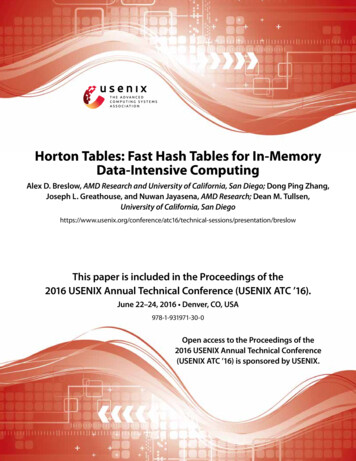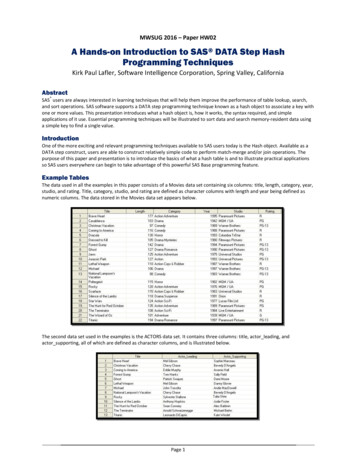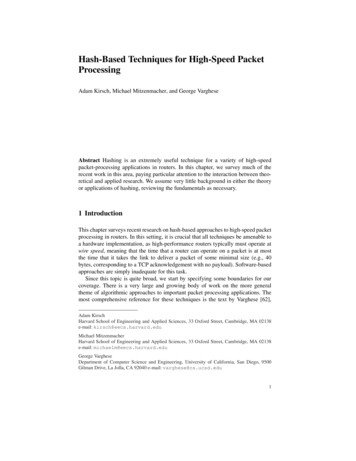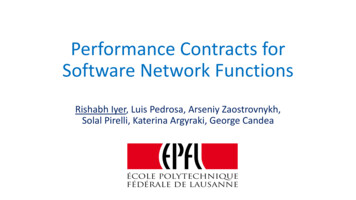
Transcription
Horton Tables: Fast Hash Tables for In-MemoryData-Intensive ComputingAlex D. Breslow, AMD Research and University of California, San Diego; Dong Ping Zhang,Joseph L. Greathouse, and Nuwan Jayasena, AMD Research; Dean M. Tullsen,University of California, San ical-sessions/presentation/breslowThis paper is included in the Proceedings of the2016 USENIX Annual Technical Conference (USENIX ATC ’16).June 22–24, 2016 Denver, CO, USA978-1-931971-30-0Open access to the Proceedings of the2016 USENIX Annual Technical Conference(USENIX ATC ’16) is sponsored by USENIX.
Horton Tables: Fast Hash Tables for In-Memory Data-Intensive ComputingAlex D. Breslow Dong Ping ZhangAMD ResearchAMD ResearchJoseph L. GreathouseAMD ResearchAbstractHash tables are important data structures that lie at theheart of important applications such as key-value storesand relational databases. Typically bucketized cuckoohash tables (BCHTs) are used because they provide highthroughput lookups and load factors that exceed 95%.Unfortunately, this performance comes at the cost of reduced memory access efficiency. Positive lookups (keyis in the table) and negative lookups (where it is not) onaverage access 1.5 and 2.0 buckets, respectively, whichresults in 50 to 100% more table-containing cache linesto be accessed than should be minimally necessary.To reduce these surplus accesses, this paper presentsthe Horton table, a revamped BCHT that reduces the expected cost of positive and negative lookups to fewer than1.18 and 1.06 buckets, respectively, while still achieving load factors of 95%. The key innovation is remapentries, small in-bucket records that allow (1) more elements to be hashed using a single, primary hash function, (2) items that overflow buckets to be tracked andrehashed with one of many alternate functions whilemaintaining a worst-case lookup cost of 2 buckets, and(3) shortening the vast majority of negative searches to 1bucket access. With these advancements, Horton tablesoutperform BCHTs by 17% to 89%.1IntroductionHash tables are fundamental data structures that areubiquitous in high-performance and big-data applications such as in-memory relational databases [12, 17, 40]and key-value stores [20, 24]. Typically these workloadsare read-heavy [4, 62]: the hash table is built once andis seldom modified in comparison to total accesses. Ahash table that is particularly suited to this behavior is abucketized cuckoo hash table (BCHT), a type of openaddressed hash table.1 BCHTs group their cells intobuckets: associative blocks of two to eight slots, witheach slot capable of storing a single element.When inserting an element, BCHTs typically selectbetween one of two independent hash functions, each ofwhich maps the key-value pair, call it KV , to a different candidate bucket. If one candidate has a free slot,KV is inserted. In the case where neither has spareslots, BCHTs resort to cuckoo hashing, a technique thatresolves collisions by evicting and rehashing elementswhen too many elements vie for the same bucket. Inthis case, to make room for KV , the algorithm selects anelement, call it KV , from one of KV ’s candidate buckets, and replaces it with KV . KV is then subsequently Thisauthor is also a PhD student at UC San Diego. Send correspondence regarding the work to abreslow@cs.ucsd.edu.USENIX AssociationNuwan JayasenaAMD ResearchDean M. TullsenUC San Diegorehashed to its alternate candidate using the remaininghash function. If the alternate bucket for KV is full, KVevicts yet another element and the process repeats untilthe final displaced element is relocated to a free slot.Although these relocations may appear to incur largeperformance overheads, prior work demonstrates thatmost elements are inserted without displacing others and,accordingly, that BCHTs trade only a modest increase inaverage insertion and deletion time in exchange for highthroughput lookups and load factors that often exceed95% with greater than 99% probability [19], a vast improvement over the majority of other techniques [60,64].BCHTs, due to this space efficiency and unparalleledthroughput, have enabled recent performance breakthroughs in relational databases and key-value storeson server processors [20, 60, 64] as well as on accelerators such as GPUs [71], the Xeon Phi [15, 60],and the Cell processor [34, 64]. However, althoughBCHTs are higher-performing than other open addressing schemes [60, 64], we find that as the performance ofmodern computing systems becomes increasingly constrained by memory bandwidth [1, 11, 52, 70], they toosuffer from a number of inefficiencies that originate fromhow data is fetched when satisfying queries.Carefully coordinating table accesses is integral tothroughput in hash tables. Because of the inherent randomness of hashing, accesses to hash tables often exhibit poor temporal and spatial locality, a property thatcauses hardware caches to become increasingly less effective as tables scale in size. For large tables, cachelines containing previously accessed hash table bucketsare frequently evicted due to capacity misses before theyare touched again, degrading performance and causingapplications to become memory-bandwidth-bound oncethe table’s working set cannot be cached on-chip. Giventhese concerns, techniques that reduce accesses to additional cache lines in the table prove invaluable when optimizing hash table performance and motivate the needto identify and address the data movement inefficienciesthat are prevalent in BCHTs.Consider a BCHT that uses two independent hashfunctions to map each element to one of two candidatebuckets. To load balance buckets and attain high loadfactors, recent work on BCHT-based key-value storesinserts each element into the candidate bucket with theleast load [20,71], which means that we expect half of theelements to be hashed by each function. Consequently,on positive lookups, where the queried key is in the table, 1.5 buckets are expected to be examined. Half of1 Under open addressing, an element may be placed in more thanone location in the table. Collisions are resolved by relocating elementswithin the table rather than spilling to table-external storage.2016 USENIX Annual Technical Conference 281
the items can be retrieved by examining a single bucket,and the other half require accessing both. For negativelookups, where the queried key is not in the table, 2lookups are necessary. Given that the minimum number of buckets that might need to be searched (for bothpositive and negative lookups) is 1, this leaves a very significant opportunity for improvement.To this end, this paper presents Horton tables,2 a carefully retrofitted bucketized cuckoo hash table, whichtrades a small amount of space for achieving positive andnegative lookups that touch close to 1 bucket apiece. Ourscheme introduces remap entries, small and succinct inbucket records that enable (1) the tracking of past hashing decisions, (2) the use of many hash functions for little to no cost, and (3) most lookups, negative and positive alike, to be satisfied with a single bucket access andat most 2. Instead of giving equal weight to each hashfunction, which leads to frequent fetching of unnecessary buckets, we employ a single primary hash function that is used for the vast majority of elements in thetable. By inducing such heavy skew, most lookups canbe satisfied by accessing only a single bucket. To permitthis biasing, we use several secondary hash functions (7in our evaluations) to rehash elements to alternate buckets when their preferred bucket lacks sufficient capacityto directly store them. Rather than forgetting our choiceof secondary hash function for remapped elements, weconvert one of the slots in each bucket that overflows intoa remap entry array that encodes which hash functionwas used to remap each of the overflow items. It is thisability to track all remapped items at low cost, both interms of time and space, that permits the optimizationsthat give Horton tables their performance edge over theprior state-of-the-art.To achieve this low cost, instead of storing an explicit tag or fingerprint (a succinct hash representationof the remapped object) as is done in cuckoo filters [21]and other work [8, 13], we instead employ implicit tags,where the index into the remap entry array is a tag computed by a hash function Htag on the key. This spaceoptimization permits all buckets to use at most 64 bits ofremap entries in our implementation while recording allremappings, even for high load factors and tables withbillions of elements. As a further optimization, we onlyconvert the last slot of each bucket into a remap entryarray when necessary. For buckets that do not overflow,they remain as standard buckets with full capacity, whichpermits load factors that exceed 90 and 95 percent for 4and 8-slot buckets, respectively.Our main contributions are as follows: We develop and evaluate Horton tables and demonstrate speed improvements of 17 to 89% on graphics processors (GPUs). Although our algorithm isnot specific to GPUs, GPUs represent the most efficient platform for the current state of the art, andthus it is important to demonstrate the effectivenessof Horton tables on the same platform. We present algorithms for insertions, deletions, andlookups on Horton tables. We conduct a detailed analysis of Horton tables byderiving and empirically validating models for their2 Namedfor elephants’ remarkable recall powers [18].282 2016 USENIX Annual Technical Conferenceexpected data movement and storage overheads. We investigate additional optimizations for insertions and deletions that further reduce data movement when using multiple hash functions, reclaiming remap entries once their remapped elements aredeleted, even when they are shared by two or moretable elements.This paper is organized as follows: In Section 2 weelaborate on the interplay between BCHTs and single instruction multiple data (SIMD) processors, in Section 3we describe BCHTs, in Section 4 we provide a high-leveloverview of Horton tables, in Section 5 we describe thelookup, insertion, and deletion algorithms for Horton tables, and then in Section 6 we present our models forHorton tables that include the cost of insertions, deletions, and remap entry storage. Section 7 covers our experimental methodology, and Section 8 contains our performance and model validation results. Related work isdescribed in Section 9 and Section 10 concludes.2The Role of SIMDIn key places in this paper, we make references toSIMD and GPU architectures. Although not necessaryfor understanding our innovations, these references arepresent due to SIMD’s importance for high-throughputimplementations of in-memory hash tables and BCHTsin particular.Recent work in high-performance databases that leverages BCHTs has shown that SIMD implementationsof BCHTs, as well as larger data processing primitives, are often more than 3 faster than the highestperforming implementations that use scalar instructionsalone [6, 44, 60]. These SIMD implementations enablebillions of lookups per second to be satisfied on a single server [60, 71], an unimaginable feat only a fewyears ago. At the same time, SIMD implementationsof BCHTs are faster than hash tables that use otheropen addressing methods [60, 64]. Such implementations are growing in importance because both CPUs andGPUs require writing SIMD implementations to maximize performance-per-watt and reduce total cost of ownership.For these reasons, we focus on a SIMD implementation of BCHTs as a starting point and endeavor to showthat all further optimizations provided by Horton tablesnot only have theoretical models that justify their performance edge (Section 6) but also that practical SIMD implementations deliver the performance benefits that thetheory projects (Section 8).33Background on BCHTsIn this section, we describe in detail BCHTs and theassociated performance considerations that arise out oftheir interaction with the memory hierarchy of today’ssystems.To begin, we illustrate two common scenarios that aretriggered by the insertion of two different key-value pairsKV1 and KV2 into the hash table, as shown in Figure 1.Numbered rows correspond to buckets, and groups of3 For a primer on SIMD and GPGPU architectures, we recommendthese excellent references: H&P (Ch. 4) [30] and Keckler et al. [39].USENIX Association
01abcEMPTYefg234dhim56qtEMPTY EMPTY EMPTYjnkolprusvEMPTYKEYwH1INSERT KV1H2H2INSERT KV2H1VALUEFigure 1: Inserting items KV1 and KV2 into a BCHTfour cells within a row to slots. In this example, H1 andH2 correspond to the two independent hash functions thatare used to hash each item to two candidate buckets (0and 2 for KV1 , 3 and 6 for KV2 ). Both H1 and H2 are aviable choice for KV1 because both buckets 0 and 2 havefree slots. Deciding which to insert into is at the discretion of the algorithm (see Section 3.3 for more details).For KV2 , both H1 and H2 hash it to buckets that arealready full, which is resolved by evicting one of the elements (in this case u), and relocating it and other conflicting elements in succession using a different hash function until a free slot is found.4 So e moves to the emptyposition in bucket 5, m to e’s old position, u to m’s oldposition, and KV2 to u’s old position. Li, et al. demonstrated that an efficient way to perform these displacements is to first conduct a breadth-first search startingfrom the candidate buckets and then begin moving elements only once a path to a free slot is discovered [47].3.1State-of-Practice ImplementationA number of important parameters affect the performance of BCHTs. In particular, the number of hash functions (f ) and the number of slots per bucket (S) impactthe achievable load factor (i.e., how full a table can befilled) as well as the expected lookup time. A hash tablewith more slots per bucket can more readily accommodate collisions without requiring a rehashing mechanism(such as cuckoo hashing) and can increase the table’sload factor. Most implementations use four [20,60,64] oreight [71] slots per bucket, which typically leads to oneto two buckets per hardware cache line. Using more slotscomes at the cost of more key comparisons on lookups,since the requested element could be in any of the slots.Increasing f , the number of hash functions, allows akey-value pair to be mapped to more buckets, as eachhash function maps the item to one of f different buckets. This improved flexibility when placing an item permits the hash table to achieve a higher load factor. However, on lookups, more buckets need to be searched because the element could be in more locations. In practice,f 2 is used most often because it permits sufficientflexibility in where keys are mapped without sufferingfrom having to search too many buckets [20, 54, 63].BCHTs are primarily designed for fast lookups. Theget operation on any key requires examining the contentsof at most f buckets. Because buckets have a fixed width,4 So in this example, elements on the chain that were originallyhashed with H1 would be rehashed using H2 and vice versa.USENIX Associationthe lookup operation on a bucket can be unrolled and efficiently vectorized. These traits allow efficient SIMD implementations of BCHTs that achieve lookup rates superior to linear probing and double-hashing-based schemeson past and present server architectures [60, 64] and accelerators such as Intel’s Xeon Phi [60].3.2Memory Traffic on LookupsLike prior work, we divide lookups into two categories: (1) positive, where the lookup succeeds becausethe key is found in the hash table, and (2) negative wherethe lookup fails because the key is not in the table.Prior work diverges on the precise method of accessing the hash table during lookups. The first method,which we term latency-optimized, always accesses allbuckets where an item may be found [47, 64]. Anothertechnique, which we call bandwidth-optimized, avoidsfetching additional buckets where feasible [20, 71].Given f independent hash functions where each ofthem maps each item to one of f candidate buckets, thelatency-optimized approach always touches f bucketswhile the bandwidth-optimized one touches, on average,( f 1)/2 buckets on positive lookups and f buckets onnegative lookups. For our work, we compare against thebandwidth-optimized approach, as it moves less data onaverage. Reducing such data movement is a greater performance concern on throughput-oriented architecturessuch as GPUs, since memory latency is often very effectively hidden on these devices [23]. Thus, we compareagainst the more bandwidth-oriented variant of BCHT,which searches 1.5 buckets instead of 2 (or more, if thereare more hash functions) for positive lookups.3.3Insertion Policy and LookupsUnlike the latency-optimized scheme, the bandwidthoptimized algorithm searches the buckets in some defined order. If an item is found before searching thelast of the f candidate buckets, then we can reduce thelookup’s data movement cost by skipping the searchof the remaining candidate buckets. Thus if f is 2,and we call the first hash function H1 and the secondH2 , then the average lookup cost across all insertedkeys is 1 * (fraction of keys that use H1 ) 2 * (fraction of keys that use H2 ).Therefore, the insertion algorithm’s policy on when to use H1or H2 affects the lookup cost.Given that hash tables almost always exhibit poor temporal and spatial locality, hash tables with working setsthat are too large to fit in caches are bandwidth-boundand are quite sensitive to the comparatively limited offchip bandwidth. In the ideal case, we therefore want totouch as few buckets as possible. If we can strongly favor using H1 over H2 during insertions, we can reduce thepercentage of buckets that are fetched that do not containthe queried key, which reduces per-lookup bandwidth requirements as well as cache pollution, both of which improve lookup throughput.Existing high-throughput,bandwidth-optimizedBCHT implementations [20, 71] attempt to load-balancebuckets on insertion by examining all buckets the keycan map to and placing elements into the buckets withthe most free slots. As an example, in Figure 1, KV1would be placed in the bucket hashed to by H2 . The2016 USENIX Annual Technical Conference 283
intuition behind this load balancing is that it bothreduces the occurrence of cuckoo rehashing, which iscommonly implemented with comparatively expensiveatomic swap operations, and increases the anticipatedload factor. Given this policy, H1 and H2 are both usedwith equal probability, which means that 1.5 buckets aresearched on average for positive lookups. We refer tothis approach as the load-balancing baseline.An alternative approach is to insert items into the firstcandidate bucket that can house them. This technique reduces the positive lookup costs, since it favors the hashfunctions that are searched earlier. We refer to this as thefirst-fit heuristic. As an example, in Figure 1, KV1 wouldbe placed in the final slot of the top bucket of the tableeven though bucket 2 has more free slots. This policymeans that items can be located with fewer memory accesses, on average, by avoiding fetching candidate buckets that follow a successful match. When the table is notparticularly full, most elements can be inserted and retrieved by accessing a single table cache line.Although prior work mentions this approach [19, 64],they do not evaluate its performance impact on lookups.Ross demonstrated its ability to reduce the cost of inserts but does not present data on its effect on lookups,instead opting to compare his latency-optimized lookupalgorithm that always fetches f buckets to other open addressing methods and chaining [64]. Erlingsson et al. usethe first-fit heuristic, but their results focus on the number of buckets accessed on insertions and feasible loadfactors for differing values of f and S (number of slotsper bucket) and not the heuristic’s impact on lookup performance [19]. For the sake of completeness, we evaluate both the load-balancing and first-fit heuristics in Section 8.One consequence of using first-fit is that, because itless evenly balances the load across buckets, once the table approaches capacity, a few outliers repeatedly hash tobuckets that are already full, necessitating long, cuckoodisplacement chains when only 2 hash functions areused. Whereas we were able to implement the insertionroutine for the load-balancing baseline and attain highload factors by relocating at most one or two elements,the first-fit heuristic prompted us to implement a serialversion of the BFS approach described by Li et al. [47]because finding long displacement chains becomes necessary for filling the table to a comparable level. One solution to reducing these long chains is to use more hashfunctions. However, for BCHTs, this increases both theaverage- and worst-case lookup costs because each itemcan now appear in more distinct buckets. In the sectionsthat follow, we demonstrate that these tradeoffs can be effectively circumvented with our technique and that thereare additional benefits such as fast negative lookups.4Horton TablesHorton tables are an extension of bucketized cuckoohash tables that largely resolve the data movement issues of their predecessor when accessing buckets duringlookups. They use two types of buckets (Figure 2): oneis an unmodified BCHT bucket (Type A) and the otherbucket flavor (Type B) contains additional in-bucketmetadata to track elements that primarily hash to thebucket but have to be remapped due to insufficient ca-284 2016 USENIX Annual Technical ConferenceType AKey‐Value [8]64 bytes8xKeyValue4 4 bytesType BKey‐Value [7]56 bytes7xKeyValue4 4 bytesRemap Entry [21]8 bytes (1 unused bit)21x Function ID3 bits (empty 7 alternate buckets)Figure 2: Horton tables use 2 bucket variants: Type A(an unmodified BCHT bucket) and Type B (converts finalslot into remap entries)pacity. All buckets begin as Type A and transition toType B once they overflow, enabling the aforementionedtracking of displaced elements. This ability to track allremapped items at low cost, both in terms of time andspace, permits the optimizations that give Horton tablestheir performance edge over the prior state of the art.Horton tables use H primary , the primary hash function, to hash the vast majority of elements so that mostlookups only require one bucket access. When insertingan item KV (K,V ), it is only when the bucket at index H primary (K) cannot directly store KV that the itemuses one of several secondary hash functions to remapthe item. We term the bucket at index Hprimary (K) theprimary bucket and buckets referenced by secondaryhash functions secondary buckets. Additionally, primary items are key-value pairs that are directly housedin the bucket referenced by the primary hash functionHprimary , and secondary items are those that have beenremapped. There is no correlation between the bucket’stype and its primacy; Type A and B buckets can simultaneously house both primary and secondary elements.Type B buckets convert the final slot of Type A buckets into a remap entry array, a vector of k-bit5 elementsknown as remap entries that encode the secondary hashfunction ID used to rehash items that cannot be accommodated in their primary bucket. Remap entries cantake on one of 2k different values, 0 for encoding an unused remap entry, and 1 to 2k 1 for encoding whichof the secondary hash functions R1 to R2k 1 was usedto remap the items. To determine the index at whicha remapped element’s remap entry is stored, a tag hashfunction known as Htag is computed on the element’s keywhich maps to a spot in the remap entry array.Remap entries are a crucial innovation of Horton tables, as they permit all secondary items to be tracked sothat at most one primary and sometimes one secondaryhash function need to be evaluated during table lookupsregardless of whether (1) the lookup is positive or negative and (2) how many hash functions are used to rehashsecondary items. At the same time, their storage is compactly allocated directly within the hash table bucket thatoverflows, boosting the locality of their accesses whilestill permitting high table load factors.5 k could range from 1 to the width of a key-value pair in bits, butwe have found k 3 to be a good design point.USENIX Association
8533EMPTY15233715 R35182223351822437EMPTY EMPTY3843EMPTY EMPTY10EMPTY EMPTY EMPTYE E785EMPTY EMPTY3843723 R102EMPTY EMPTY EMPTY27E5237E ER54Figure 3: Comparison of a bucketized cuckoo hash table (L) and a Horton table (R). E empty remapy entry.With Horton tables, most lookups only require touching a single bucket and a small minority touch two. Atthe same time remap entries typically use at most several percent of the table’s capacity, leaving sufficient freespace for Horton tables to achieve comparable load factors to BCHTs.Figure 2 shows the Type A and Type B bucket designsgiven 4-byte keys and values and 8-slot buckets. Thebucket type is encoded in one bit of each bucket. ForType A buckets, this costs us a bit from just one of thevalue fields (now 31 bits). For Type B buckets, we encode 21 3-bit remap entries into a 64-bit slot, so we havea bit to spare already. If we have a value that requires all32 bits in the last slot of a Type A bucket, we can move itto another slot in this bucket or remap to another bucket.Because Type B buckets can house fewer elementsthan Type A buckets, Type A buckets are used as much aspossible. It is only when a bucket has insufficient capacity to house all primary items that hash to it that it is converted into a Type B bucket, a process known as promotion. To guarantee that elements can be found quickly,whenever possible we enforce that primary elements arenot displaced by secondary items. This policy ensuresboth that more buckets remain Type A buckets and thatmore items are primary elements.4.1A Comparison with BCHTsFigure 3 shows a high-level comparison of Horton tables with an f 2, traditional BCHT that stores the samedata. Buckets correspond to rows and slots to individual cells within each row. In the Horton table (right),each item maps to its primary bucket by default. Bucket2 (zero indexing) has been promoted from Type A toType B because its 4 slots are insufficient to directlyhouse the 6 key-value pairs that H primary has hashedthere: 35, 18, 22, 7, 23, and 4. Because there is insufficient space to house 7, 23, and 4 directly in Bucket2, they are remapped with hash functions R7 , R2 , andR5 , respectively, and the function IDs are stored directlyin the remap entry array at the indices referenced byHtag (7) 0, Htag (23) 3, and Htag (3) 2. If we contrast the Horton table and the associated cuckoo hash table, we find that, of the shown buckets, the Horton tablehas a lookup cost of 1 for elements 8, 5, 33, 15, 2, 35, 18,22, and 37 and a lookup cost of 2 for 7, 23, and 4, whichaverages out to 1.25. By contrast the bucketized cuckoohash table has an expected lookup cost of 1.5 [20, 71] or2.0 [47, 64], depending on the implementation.USENIX AssociationCompute Hprimary(K)x Compute tag hash t with Htag(K)tIf remap entry at index t is empty, return KNFDetermine if K matchesElse go toan item in bucket xREA[t].isEmpty()?If match found, return it.Else if x.isTypeA(),return KNFK b.key?153Else go to02014EMPTY EMPTYKHprimaryx abcdefg REAKR3w hijklmn REACompute the secondary hash functionspecified by the remap entry (R3) andcheck if K matches an item in wIf there is match, return it.Else return KNFFigure 4: Horton table lookups. KNF and REA are abbreviations for key not found and remap entry array.5AlgorithmsIn this section, we describe the algorithms that we useto look up, insert, and delete elements in Horton tables.We begin each subsection by detailing the functionalcomponents of the algorithms and then, where relevant,briefly outline how each algorithm can be efficiently implemented using SIMD instructions.5.1Lookup OperationOur lookup algorithm (Figure 4) works as follows.1 Given a key K, we first compute H primary (K), whichgives us the index of K’s primary bucket. 2 We next ex-amine the first S isTypeB() slots of the bucket, whereisTypeB() returns 1 if Bucket x is Type B and 0 if itis Type A by checking the bucket’s most significant bit.3 If the key is found, we return the value. In the casethat the key is not found and the bucket is Type A, thenthe element cannot appear in any other bucket, and so wecan declare the key not found.4 If, however, the bucket is Type B, then we must examine the remap entry array when the item is not foundin the first S 1 slots of K’s primary bucket (Bucket x).We first compute Htag (K) to determine the index into theremap entry array (shown as t 14 in the figure). 5 Ifthe value at that slot is 0, which signifies empty, thenwe declare the key not found because the key cannot appear in any other bucket. However, if the remap entry isset, then 6 we evaluate the secondary function Ri specified by the remap entry (R3 in Figure 4) on a combination of the primary bucket and remap entry index (seeSection 5.3.4) to get the index of the secondary bucket(Bucket w). We then compare K to the first S isTypeB()elements of w. 7 If we get a match, then we returnit. If we do not get a match, then because an elementis never found outside of its primary bucket or the secondary bucket specified by its remap entry, then we declare the key not found. It cannot be anywhere else.5.2SIMD Implementation of LookupsOur approach leverages bulk processing of lookupsand takes a large array of keys as input and writesout a corresponding array of retrieved values as output. We implement a modified version of Zhang et al.’slookup algorithm [71], which virtualizes the SIMD unitinto groups of S lanes (akin to simple cores that coexecute the same instruction stream) and assigns each2016 USENIX Annual Technical Conferen
tions such as in-memory relational databases [12,17,40] and key-value stores [20,24]. Typically these workloads are read-heavy [4,62]: the hash table is built once and is seldom modified in comparison to total accesses. A hash table that is particularly suited to this behavior is a bucketized cuckoo hash table (BCHT), a type of open-










